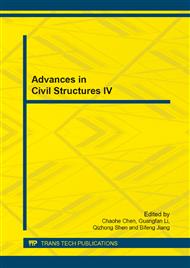p.907
p.917
p.921
p.925
p.929
p.936
p.940
p.946
p.950
Numerical Analysis and Calculation of Internal Forces of Steel Box Continuous Girder Bridge Construction Process
Abstract:
In order to determine the most unfavorable condition of the steel box girder, ensure its stress and deformation in the safe state, the steel box girder bridge should apply the finite element analysis software to modeling analysis. At the same time, data calculation can provide the theoretical evidence for the factory manufacturing lines. The tender DB01 of the continuous bridge of the Hong Kong-Zhuhai-Macao Bridge provides the backdrop for this essay, using MIDAS/Civil 2012 to do numeral simulation analysis on the hoisting, and then analyzing the stress and deformation of the main beam at the different construction stages. The analysis reveals that the temporary maximum of a hinged steel box girder should be 47.5MPa in the process of construction which is allowed by the stress of the steel Q 345.And after the No.1 beam has been put in the right place and connected, the maximum displacement of the No.6 joint is 19.4mm downward. With the construction stage CS7 completed, the maximum downward displacement is 14.2mm. Making the stress free alignment is superposing the minus figure of the cumulative displacement on the basis of designed line. Each beam segment has been made according to the stress free alignment .Also, after field construction, the ideology of designed lines of the bridge will be brought into reality.
Info:
Periodical:
Pages:
929-935
Citation:
Online since:
July 2014
Authors:
Price:
Сopyright:
© 2014 Trans Tech Publications Ltd. All Rights Reserved
Share:
Citation:


